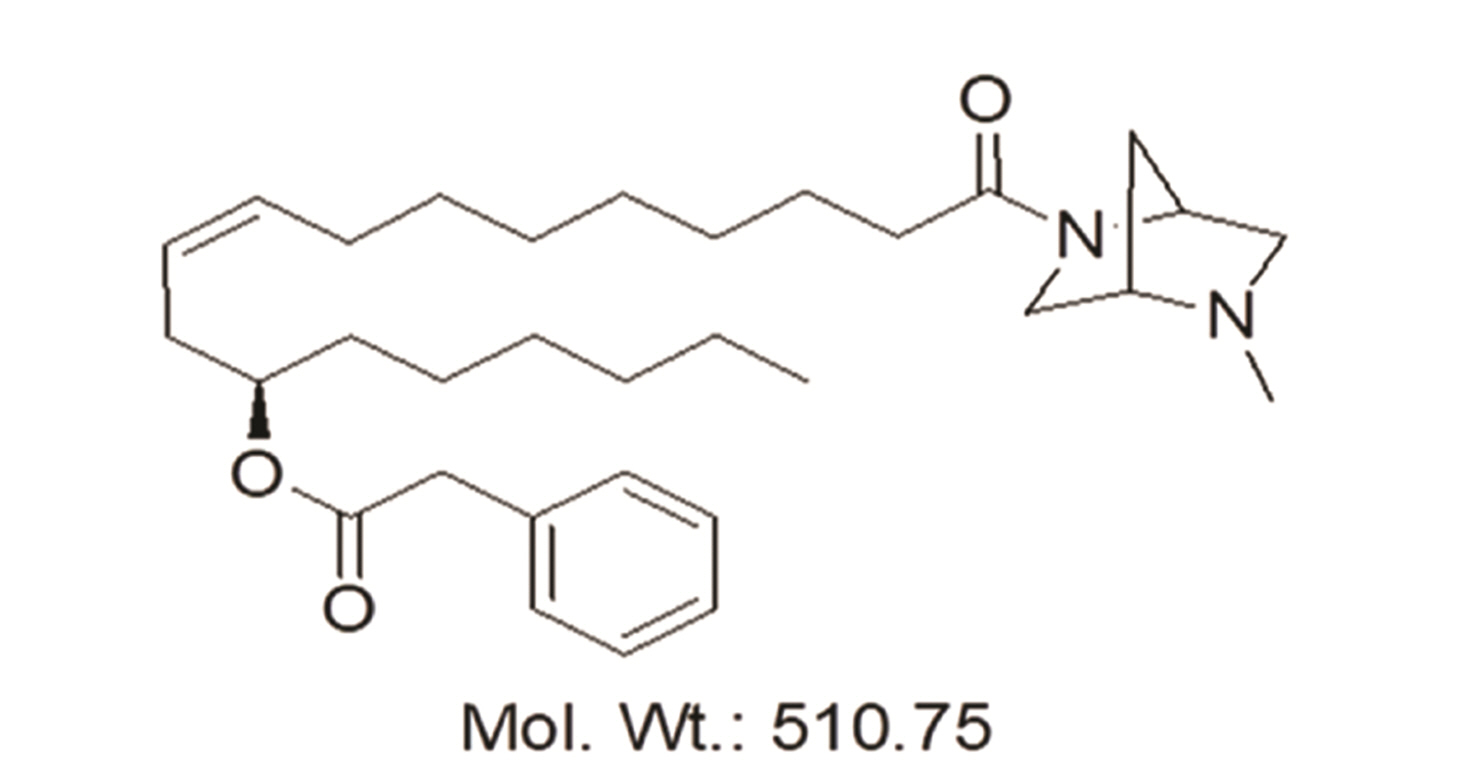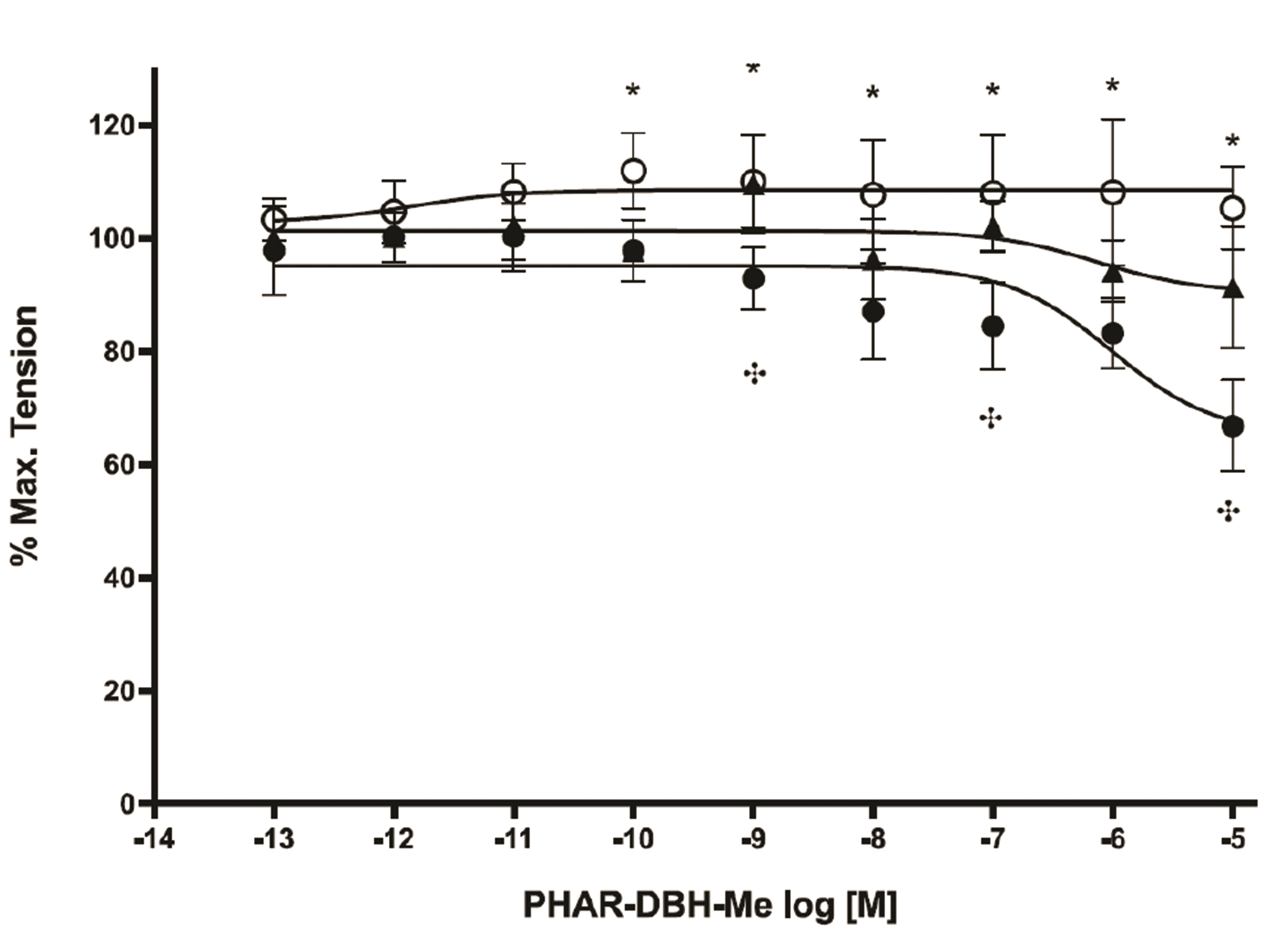Korean J Physiol Pharmacol.
2022 Mar;26(2):77-86. 10.4196/kjpp.2022.26.2.77.
Characterization of hypotensive and vasorelaxant effects of PHAR-DBH-Me a new cannabinoid receptor agonist
- Affiliations
-
- 1Department of Physiology, School of Medicine, National Autonomous University of Mexico, Mexico City 04510, Mexico.
- 2Department of Pharmacology, National Institute of Cardiology, Mexico City 14080, Mexico.
- 3Department of Anatomy, School of Medicine, National Autonomous University of Mexico, Mexico City 04510, Mexico.
- 4Department of Biochemistry, School of Medicine, National Autonomous University of Mexico, Mexico City 04510, Mexico.
- 5Drug Synthesis Laboratory, UMIEZ, Zaragoza School of Higher Education, National Autonomous University of Mexico, Mexico City 09230, Mexico.
- KMID: 2526727
- DOI: http://doi.org/10.4196/kjpp.2022.26.2.77
Abstract
- The effect of PHAR-DBH-Me, a cannabinoid receptor agonist, on different cardiovascular responses in adult male rats was analyzed. The blood pressure was measured directly and indirectly. The coronary flow was measured by Langendorff preparation, and vasomotor responses induced by PHAR-DBH-Me in aortic rings precontracted with phenylephrine (PHEN) were analyzed. The intravenous injection of the compound PHAR-DBH-Me (0.018–185 µg/kg) resulted in decreased blood pressure; maximum effect was observed at the dose of 1,850 µg/kg. A concentrationdependent increase in the coronary flow was observed in a Langendorff preparation. In the aortic rings, with and without endothelium, pre-contracted with PHEN (10–6 M), the addition of PHAR-DBH-Me to the superfusion solution (10–12 –10 –5 M), produced a vasodilator response, which depends on the concentration and presence of the endothelium. L-NAME inhibited these effects. Addition of CB 1 receptor antagonist (AM 251) did not modify the response, while CB2 receptor antagonist (AM630) decreased the potency of relaxation elicited by PHAR-DBH-Me. Indomethacin shifted the curve concentration-response to the left and produced an increase in the magnitude of the maximum endothelium dependent response to this compound. The maximum effect of PHAR-DBH-Me was observed with the concentration of 10 –5 M. These results show that PHAR-DBH-Me has a concentration-dependent and endothelium-dependent vasodilator effect through CB2 receptor. This vasodilation is probably mediated by the synthesis/release of NO. On the other hand, it is suggested that PHAR-DBH-Me also induces the release of a vasoconstrictor prostanoid.
Keyword
Figure
Reference
-
1. Devane WA, Hanus L, Breuer A, Pertwee RG, Stevenson LA, Griffin G, Gibson D, Mandelbaum A, Etinger A, Mechoulam R. 1992; Isolation and structure of a brain constituent that binds to the cannabinoid receptor. Science. 258:1946–1949. DOI: 10.1126/science.1470919. PMID: 1470919.
Article2. Sugiura T, Kondo S, Sukagawa A, Nakane S, Shinoda A, Itoh K, Yamashita A, Waku K. 1995; 2-Arachidonoylglycerol: a possible endogenous cannabinoid receptor ligand in brain. Biochem Biophys Res Commun. 215:89–97. DOI: 10.1006/bbrc.1995.2437. PMID: 7575630.
Article3. Cravatt BF, Prospero-Garcia O, Siuzdak G, Gilula NB, Henriksen SJ, Boger DL, Lerner RA. 1995; Chemical characterization of a family of brain lipids that induce sleep. Science. 268:1506–1509. DOI: 10.1126/science.7770779. PMID: 7770779.
Article4. Pertwee RG. 2010; Receptors and channels targeted by synthetic cannabinoid receptor agonists and antagonists. Curr Med Chem. 17:1360–1381. DOI: 10.2174/092986710790980050. PMID: 20166927. PMCID: PMC3013229.
Article5. Steffens S, Pacher P. 2012; Targeting cannabinoid receptor CB2 in cardiovascular disorders: promises and controversies. Br J Pharmacol. 167:313–323. DOI: 10.1111/j.1476-5381.2012.02042.x. PMID: 22612332. PMCID: PMC3481040.
Article6. Zou S, Kumar U. 2018; Cannabinoid receptors and the endocannabinoid system: signaling and function in the central nervous system. Int J Mol Sci. 19:833. DOI: 10.3390/ijms19030833. PMID: 29533978. PMCID: PMC5877694.
Article7. Hiley CR. 2009; Endocannabinoids and the heart. J Cardiovasc Pharmacol. 53:267–276. DOI: 10.1097/FJC.0b013e318192671d. PMID: 19276990. PMCID: PMC2728560.
Article8. Aghazadeh Tabrizi M, Baraldi PG, Borea PA, Varani K. 2016; Medicinal chemistry, pharmacology, and potential therapeutic benefits of cannabinoid CB2 receptor agonists. Chem Rev. 116:519–560. DOI: 10.1021/acs.chemrev.5b00411. PMID: 26741146.
Article9. Rom S, Zuluaga-Ramirez V, Dykstra H, Reichenbach NL, Pacher P, Persidsky Y. 2013; Selective activation of cannabinoid receptor 2 in leukocytes suppresses their engagement of the brain endothelium and protects the blood-brain barrier. Am J Pathol. 183:1548–1558. DOI: 10.1016/j.ajpath.2013.07.033. PMID: 24055259. PMCID: PMC3814716.
Article10. Page RL 2nd, Allen LA, Kloner RA, Carriker CR, Martel C, Morris AA, Piano MR, Rana JS, Saucedo JF. American Heart Association Clinical Pharmacology Committee and Heart Failure and Transplantation Committee of the Council on Clinical Cardiology. Council on Basic Cardiovascular Sciences. Council on Cardiovascular and Stroke Nursing. Council on Epidemiology and Prevention. Council on Lifestyle and Cardiometabolic Health. Council on Quality of Care and Outcomes Research. 2020; Medical marijuana, recreational cannabis, and cardiovascular health: a scientific statement from the American Heart Association. Circulation. 142:e131–e152. DOI: 10.1161/CIR.0000000000000883. PMID: 32752884.
Article11. López-Ortíz M, Herrera-Solís A, Luviano-Jardón A, Reyes-Prieto N, Castillo I, Monsalvo I, Demare P, Méndez-Díaz M, Regla I, Prospéro-García O. 2010; Chemoenzymatic synthesis and cannabinoid activity of a new diazabicyclic amide of phenylacetylricinoleic acid. Bioorg Med Chem Lett. 20:3231–3234. DOI: 10.1016/j.bmcl.2010.04.074. PMID: 20457524.
Article12. Vidrio H, Medina M, González-Romo P, Lorenzana-Jiménez M, Díaz-Arista P, Baeza A. 2003; Semicarbazide-sensitive amine oxidase substrates potentiate hydralazine hypotension: possible role of hydrogen peroxide. J Pharmacol Exp Ther. 307:497–504. DOI: 10.1124/jpet.103.055350. PMID: 12970383.
Article13. Maggi CA, Meli A. 1986; Suitability of urethane anesthesia for physiopharmacological investigations in various systems. Part 2: cardiovascular system. Experientia. 42:292–297. DOI: 10.1007/BF01942510. PMID: 3007197.
Article14. Furchgott RF, Zawadzki JV. 1980; The obligatory role of endothelial cells in the relaxation of arterial smooth muscle by acetylcholine. Nature. 288:373–376. DOI: 10.1038/288373a0. PMID: 6253831.
Article15. Sudhahar V, Shaw S, Imig JD. 2009; Mechanisms involved in oleamide-induced vasorelaxation in rat mesenteric resistance arteries. Eur J Pharmacol. 607:143–150. DOI: 10.1016/j.ejphar.2009.02.002. PMID: 19326479. PMCID: PMC2664517.
Article16. Quiñonez-Bastidas GN, Palomino-Hernández O, López-Ortíz M, Rocha-González HI, González-Anduaga GM, Regla I, Navarrete A. 2020; Antiallodynic effect of PhAR-DBH-Me involves cannabinoid and TRPV1 receptors. Pharmacol Res Perspect. 8:e00663. DOI: 10.1002/prp2.663. PMID: 32965798. PMCID: PMC7510332.
Article17. Ligresti A, De Petrocellis L, Di Marzo V. 2016; From phytocannabinoids to cannabinoid receptors and endocannabinoids: pleiotropic physiological and pathological roles through complex pharmacology. Physiol Rev. 96:1593–1659. DOI: 10.1152/physrev.00002.2016. PMID: 27630175.
Article18. Pertwee RG. 2015; Endocannabinoids and their pharmacological actions. Handb Exp Pharmacol. 231:1–37. DOI: 10.1007/978-3-319-20825-1_1. PMID: 26408156.
Article19. Hebert-Chatelain E, Desprez T, Serrat R, Bellocchio L, Soria-Gomez E, Busquets-Garcia A, Pagano Zottola AC, Delamarre A, Cannich A, Vincent P, Varilh M, Robin LM, Terral G, García-Fernández MD, Colavita M, Mazier W, Drago F, Puente N, Reguero L, Elezgarai I, et al. 2016; A cannabinoid link between mitochondria and memory. Nature. 539:555–559. DOI: 10.1038/nature20127. PMID: 27828947.
Article20. Mendizabal-Zubiaga J, Melser S, Bénard G, Ramos A, Reguero L, Arrabal S, Elezgarai I, Gerrikagoitia I, Suarez J, Rodríguez De Fonseca F, Puente N, Marsicano G, Grandes P. 2016; Cannabinoid CB1 receptors are localized in striated muscle mitochondria and regulate mitochondrial respiration. Front Physiol. 7:476. DOI: 10.3389/fphys.2016.00476. PMID: 27826249. PMCID: PMC5078489.21. Bonz A, Laser M, Küllmer S, Kniesch S, Babin-Ebell J, Popp V, Ertl G, Wagner JA. 2003; Cannabinoids acting on CB1 receptors decrease contractile performance in human atrial muscle. J Cardiovasc Pharmacol. 41:657–664. DOI: 10.1097/00005344-200304000-00020. PMID: 12658069.
Article22. Chen XP, Yang W, Fan Y, Luo JS, Hong K, Wang Z, Yan JF, Chen X, Lu JX, Benovic JL, Zhou NM. 2010; Structural determinants in the second intracellular loop of the human cannabinoid CB1 receptor mediate selective coupling to GS and Gi. Br J Pharmacol. 161:1817–1834. DOI: 10.1111/j.1476-5381.2010.01006.x. PMID: 20735408. PMCID: PMC3010585.
Article23. Zheng C, Chen L, Chen X, He X, Yang J, Shi Y, Zhou N. 2013; The second intracellular loop of the human cannabinoid CB2 receptor governs G protein coupling in coordination with the carboxyl terminal domain. PLoS One. 8:e63262. DOI: 10.1371/journal.pone.0063262. PMID: 23667597. PMCID: PMC3646771. PMID: c7698747d4954bb6ac82f59c1fea7812.
Article24. Lozovaya N, Min R, Tsintsadze V, Burnashev N. 2009; Dual modulation of CNS voltage-gated calcium channels by cannabinoids: focus on CB1 receptor-independent effects. Cell Calcium. 46:154–162. DOI: 10.1016/j.ceca.2009.07.007. PMID: 19682741.
Article25. Wheal AJ, Bennett T, Randall MD, Gardiner SM. 2007; Cardiovascular effects of cannabinoids in conscious spontaneously hypertensive rats. Br J Pharmacol. 152:717–724. DOI: 10.1038/sj.bjp.0707410. PMID: 17700721. PMCID: PMC2190006.
Article26. Ho WS, Gardiner SM. 2009; Acute hypertension reveals depressor and vasodilator effects of cannabinoids in conscious rats. Br J Pharmacol. 156:94–104. DOI: 10.1111/j.1476-5381.2008.00034.x. PMID: 19133994. PMCID: PMC2697765.
Article27. Lépicier P, Bouchard JF, Lagneux C, Lamontagne D. 2003; Endocannabinoids protect the rat isolated heart against ischaemia. Br J Pharmacol. 139:805–815. DOI: 10.1038/sj.bjp.0705313. PMID: 12813004. PMCID: PMC1573907.
Article28. Underdown NJ, Hiley CR, Ford WR. 2005; Anandamide reduces infarct size in rat isolated hearts subjected to ischaemia-reperfusion by a novel cannabinoid mechanism. Br J Pharmacol. 146:809–816. DOI: 10.1038/sj.bjp.0706391. PMID: 16158067. PMCID: PMC1751211.
Article29. Al Kury LT, Voitychuk OI, Yang KH, Thayyullathil FT, Doroshenko P, Ramez AM, Shuba YM, Galadari S, Howarth FC, Oz M. 2014; Effects of the endogenous cannabinoid anandamide on voltage-dependent sodium and calcium channels in rat ventricular myocytes. Br J Pharmacol. 171:3485–3498. DOI: 10.1111/bph.12734. PMID: 24758718. PMCID: PMC4105935.
Article30. Hoi PM, Hiley CR. 2006; Vasorelaxant effects of oleamide in rat small mesenteric artery indicate action at a novel cannabinoid receptor. Br J Pharmacol. 147:560–568. DOI: 10.1038/sj.bjp.0706643. PMID: 16415907. PMCID: PMC1616976.
Article31. Kozłowska H, Baranowska M, Schlicker E, Kozłowski M, Laudański J, Malinowska B. 2007; Identification of the vasodilatory endothelial cannabinoid receptor in the human pulmonary artery. J Hypertens. 25:2240–2248. DOI: 10.1097/HJH.0b013e3282ef7a0a. PMID: 17921818.
Article32. Lépicier P, Lagneux C, Sirois MG, Lamontagne D. 2007; Endothelial CB1-receptors limit infarct size through NO formation in rat isolated hearts. Life Sci. 81:1373–1380. DOI: 10.1016/j.lfs.2007.08.042. PMID: 17931662.
Article33. Silva BR, Pernomian L, De Paula TD, Grando MD, Bendhack LM. 2017; Endothelial nitric oxide synthase and cyclooxygenase are activated by hydrogen peroxide in renal hypertensive rat aorta. Eur J Pharmacol. 814:87–94. DOI: 10.1016/j.ejphar.2017.07.047. PMID: 28780058.
Article34. Herradón E, Martín MI, López-Miranda V. 2007; Characterization of the vasorelaxant mechanisms of the endocannabinoid anandamide in rat aorta. Br J Pharmacol. 152:699–708. DOI: 10.1038/sj.bjp.0707404. PMID: 17704831. PMCID: PMC2190007.
Article35. Romano MR, Lograno MD. 2006; Cannabinoid agonists induce relaxation in the bovine ophthalmic artery: evidences for CB1 receptors, nitric oxide and potassium channels. Br J Pharmacol. 147:917–925. DOI: 10.1038/sj.bjp.0706687. PMID: 16474412. PMCID: PMC1760716.
Article36. Hoyer FF, Steinmetz M, Zimmer S, Becker A, Lütjohann D, Buchalla R, Zimmer A, Nickenig G. 2011; Atheroprotection via cannabinoid receptor-2 is mediated by circulating and vascular cells in vivo. J Mol Cell Cardiol. 51:1007–1014. DOI: 10.1016/j.yjmcc.2011.08.008. PMID: 21884703.
Article37. González C, Herradón E, Abalo R, Vera G, Pérez-Nievas BG, Leza JC, Martín MI, López-Miranda V. 2011; Cannabinoid/agonist WIN 55,212-2 reduces cardiac ischaemia-reperfusion injury in Zucker diabetic fatty rats: role of CB2 receptors and iNOS/eNOS. Diabetes Metab Res Rev. 27:331–340. DOI: 10.1002/dmrr.1176. PMID: 21309057.
Article38. Járai Z, Wagner JA, Varga K, Lake KD, Compton DR, Martin BR, Zimmer AM, Bonner TI, Buckley NE, Mezey E, Razdan RK, Zimmer A, Kunos G. 1999; Cannabinoid-induced mesenteric vasodilation through an endothelial site distinct from CB1 or CB2 receptors. Proc Natl Acad Sci U S A. 96:14136–14141. DOI: 10.1073/pnas.96.24.14136. PMID: 10570211. PMCID: PMC24203.
Article39. Chen G, Suzuki H, Weston AH. 1988; Acetylcholine releases endothelium-derived hyperpolarizing factor and EDRF from rat blood vessels. Br J Pharmacol. 95:1165–1174. DOI: 10.1111/j.1476-5381.1988.tb11752.x. PMID: 2851359. PMCID: PMC1854275.
Article40. Hecker M, Bara AT, Bauersachs J, Busse R. 1994; Characterization of endothelium-derived hyperpolarizing factor as a cytochrome P450-derived arachidonic acid metabolite in mammals. J Physiol. 481(Pt 2):407–414. DOI: 10.1113/jphysiol.1994.sp020449. PMID: 7738833. PMCID: PMC1155939.
Article41. Wheal AJ, Alexander SP, Randall MD. 2010; Vasorelaxation to N-oleoylethanolamine in rat isolated arteries: mechanisms of action and modulation via cyclooxygenase activity. Br J Pharmacol. 160:701–711. DOI: 10.1111/j.1476-5381.2010.00770.x. PMID: 20590573. PMCID: PMC2931569.
Article
- Full Text Links
- Actions
-
Cited
- CITED
-
- Close
- Share
- Similar articles
-
- The Cannabinoid Agonist WIN55,212-2 Suppresses Opioid-induced Pruritus in Mice
- SR144528 as Inverse Agonist of CB2 Cannabinoid Receptor
- Cannabinoid receptor agonist protects cultured dopaminergic neurons from the death by the proteasomal dysfunction
- A Cannabinoid Receptor Agonist N-Arachidonoyl Dopamine Inhibits Adipocyte Differentiation in Human Mesenchymal Stem Cells
- Functional Role of Serine Residues of Transmembrane Dopamin VII in Signal Transduction of CB2 Cannabinoid Receptor







